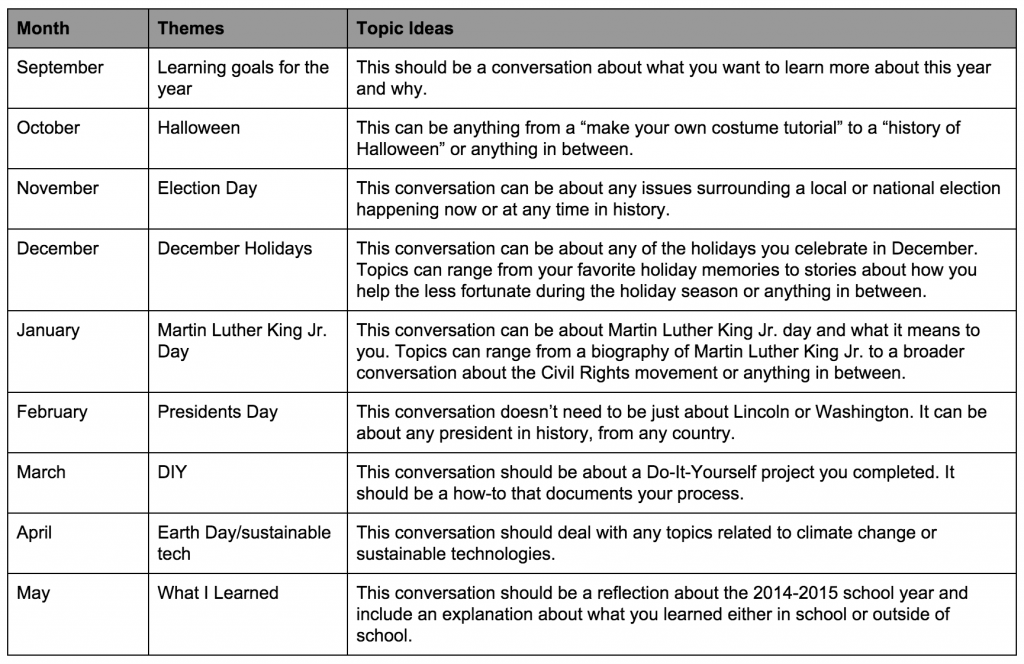We are excited to announce a new way for us to feature your work and the work of your students! Each month for the 2014-2015 school year, we will be accepting submissions for a “VoiceThread of the Month”. Each month, we will ask for an entry based on a different theme along with a link to submit the work when it’s complete.
For November, the theme is: Election Day

Are you discussing voter suppression with you students?
*Are you discussing the difference between a Democracy and a Republic? *
Are you analyzing the election results in class?
Are you evaluating the validity of the polling data?
If you said “yes” to any of these questions, turn that conversation into a VoiceThread and submit it using the link below!
Here’s how it works:
The submission can be either student or teacher created.
We are looking for conversations, not just presentations.
The VoiceThread will be judged on these 3 criteria:
1. Comment Quality– all comments should add value to the content of conversation.
2. Visuals– all images/documents/videos should be appropriate, interesting, and properly sourced.
3. Comment Quantity– more people engaged in the conversation means more shared points of view.
The winning selection for each month will be added to a special section in our digital library so everyone can see the great work you do.
Themes for the 2014-2015 school year:

*This is a guest post by educator and VoiceThreader Dr. Judy Arzt.
I use this tool in my own teaching, but, more importantly, encourage the teachers in my classes to use it with their students. The app is flexible and works on a variety of devices. For instance, teachers with limited access to technology in their classrooms can download the app to their phone. This suits those who teach the lower grades, starting with pre-k. The young children find phones easy to use and enjoy recording their voice and hearing it back. Often, they use hand-drawn illustrations from a unit of study, and the teacher uploads these, and the children record a contribution. This format allows for creating collaborative class books, as illustrated in these two examples.
Alliteration, literature project by elementary students
Animals, science project by 1st graders
VoiceThread offered a perfect match for the Alliteration project; hearing the alliteration reinforced that successive words had the same initial sound. The Animals project reviewed science concepts while introducing the genre of non-fiction. Each student voice recorded facts to accompany an hand-drawn illustration of a chosen animal. Students watched the final presentation and voice recorded replies to peers.
A kindergarten teacher, with no access to technology in the classroom, used her phone for young students to create an amusing book, with each child adding a picture and voice comment to develop the story’s plot, characters, and setting.
Mary Had a Toaster
The students enjoyed the experience so much, they created a sequel.
For young children, VoiceThread presents as way to understand content concepts in chunks. One teacher using the phone app created this lesson for her young students.
Fruit Kabob Patterns, math for pre-k students
For students in the upper elementary grades, access to tablets, laptops, or desktops facilitates the process, as illustrated in these examples.
Students Share Their Favorite Books, a collaborative class project created by 6th graders
A Poetry Presentation, a collaborative class project created by 5th graders
The Favorite Book project was one the teacher did annually at the end of the year, with each student writing a book review, with all collected in one print book to be used the following year. This approach limited how many of the new students were able to read the book simultaneously. VoiceThread put a new spin on the project. Now any student could access all the reviews in one place any time and hear the reviews.
For the poetry project, the teacher in the past had each child recite a poem at a Parent Open House. This often caused students to get nervous, and students with special needs were excluded. With VoiceThread, students uploaded the poem they wrote with an illustration and recited the poem. In this way, students had opportunities to re-record their readings, and those students who struggled in a front of a group or who had special needs succeeded. For the latter, the teacher sat with a child and mouthed the words to help the child along with the recording. The use of VoiceThread leveled the playing field and made for a smooth event for the Open House. Parents enjoyed seeing their child’s poem on the “big screen” while hearing the voice recordings. For parents who could not attend, the VoiceThread was a win!
For older students, starting in middle school, when many have mobile devices, the process extends beyond the school day. The teacher posts the VoiceThread, and students add comments via their devices, with replies occurring at the student’s convenience. One of the foreign language teacher from my course uses VoiceThread in this way. The app affords students an excellent way to practice newly acquired skills via the speech, video, and text comment options.
In teaching, I often introduce VoiceThread through a collaborative activity. Recently, in the course, “Integrating Technology and Literacy,” which enrolls pre-k through 6th-grade teachers, we created a VoiceThread of our favorite children’s books. Before class, each person sent me a picture of the book’s cover, and I uploaded each into the app.
Books We Love, Our Favorite Children’s Books
During class, each person voice recorded the reason for the selection and how the book is used with students. This quick demonstration electrified the teachers, who implemented the app with their students, and, in turn, shared out with us their students’ productions, adding to our list of possibilities.
The features of VoiceThread invite a plethora of ways for teachers to re-envision their curriculum. Once introduced to VoiceThread, teachers are stoked to use it with students. The app complements multiple intelligences theory and differentiates instruction, popular trends in education today.
About the Author: Dr. Judy Arzt has been an educator for over 25 and currently teaches graduate courses focused on technology integration. She often presents at national conferences on the topics of digital literacy, digital storytelling, blogging, and Twitter. She is easily accessible via Twitter (@judyarzt) and Google+ (judyarzt). For additional information, see her About.Me page (judyarzt)
If you’ve spent any time on the web in the last few years, you’ve probably come across hundreds of links with titles like:
“Drake just got an emoji tattoo—and you’ll never guess which one” or
“Facebook is unveiling something new on Monday” or
“You’ll never guess who wants to cater Kim Kardashian and Kanye West’s wedding”
(Those are all real headlines, btw)
These are all examples of “clickbait,” a digital marketing trend aimed at enticing readers to click on a link to help generate ad revenue for various news and entertainment sites. So why do we see so many of these types of sensational headlines?
We see so many because they work, and they work because they plant a question in the readers’ minds. The question compels the readers to click on the link to find the answer. Marketers have learned how to harness the power of basic human curiosity to engage people and encourage discovery. They bait the hook with a question and often we are curious enough that we click to find the answer.

Image Source: https://www.flickr.com/photos/pasukaru76/
At this point, some of you may be asking, “So what does this have to do with education?” The answer is that digital marketers didn’t really invent this concept; Socrates did. The Socratic Method is fundamentally about designing questions that help the student construct good answers. Like digital marketers, Socrates understood that if you ask the right questions, people can’t help but think about possible answers. It’s a brain hack. Piquing human curiosity isn’t easy but it is a fundamental element of engagement. Engagement starts with questions and ends with answers.
Why are students more curious about who wants to cater Kim and Kanye’s wedding than about how the Milky Way formed? Why are they more curious about Drake’s emoji tattoo than they are about how art and music affected the Vietnam War? If educators have more profoundly interesting content than digital marketers, why are students more curious about clickbait headlines on Upworthy or BuzzFeed than science, history and economics?
Is it because digital marketers are simply better at designing questions? How can this be? Maybe the digital marketers are better at designing questions because they ask more of them. So how do we make our educational content more clickable? Where do we start? Maybe you can start by asking yourself some questions:
When you design lessons are you designing answers for your students to memorize or are you designing questions that compel them to discover? Is your class a monologue or a dialogue? Do you believe in broadcasting answers about content or do you believe in having conversations around it?
Each month for the 2014-2015 school year, we will be accepting submissions for a “VoiceThread of the Month”.
For October, the theme is: Halloween
The themes are intentionally open-ended so you and your students can be as creative as you like.
Maybe your students are DIYers who can make a VoiceThread tutorial showing how to make a costume or carve a pumpkin.

Maybe your students can learn about the history of Halloween or how it is celebrated across the globe.

Maybe they can write ghost stories and narrate them with artwork on a VoiceThread. As long as the work fits the theme, we’d be excited to see what you do!

Here’s how it works:
The submission can be either student or teacher created.
We are looking for conversations, not just presentations.
The VoiceThread will be judged on these 3 criteria:
1. Comment Quality– all comments should add value to the content of conversation.
2. Visuals– all images/documents/videos should be appropriate, interesting, and properly sourced.
3. Comment Quantity– more people engaged in the conversation means more shared points of view.
The winning selection for each month will be added to a special section in our digital library so everyone can see the great work you do. For the full calendar of themes, check here.
You can submit your entry here:
You can share out your VoiceThread of the Month on twitter with the #VToM hashtag so everyone can see what you’ve done. Happy Halloween!

We hear about “disruptive” technology all the time, but what does it really mean? Too often the label is misapplied to technologies that simply improve efficiency while preserving an old model. For a technology to be truly disruptive it needs to bring about a fundamental change in how we do things. When it comes to educational technology, many existing tools allow traditional teachers to continue delivering lectures and assessing with short-answer tests. Technology that makes this process more efficient is not disrupting pedagogy, it’s perpetuating it.
Over the last few years the “flipped classroom” has been described as disruptive to traditional approaches. We frequently hear it described as “lecture at home, homework in class” or some variation on that theme. The problem is that neither lecture nor homework seem especially disruptive. Lecture and homework are still lecture and homework regardless of the order or location in which they are given.
Sometimes we see new technologies through an old lens. When the automobile became popular it was described as a “horseless carriage” because the disruption to the old model was still a few decades in the future. The future was there, it just wasn’t evenly distributed yet. Automobiles were disruptive because they allowed people to move out of cities and into the suburbs. Close-knit city communities didn’t realize that the suburbs were about to disrupt their way of life. They may have anticipated disruption to the horses, but not to our way of life. Many proponents of the current flipped class model are still teaching with horseless carriages. The real disruption of asynchronous, web-based technology is not evenly distributed yet either.

While true expertise in any given subject is still scarce, information about that subject is not. So why do we still create flipped classrooms with an information-scarcity mindset? We no longer need to give lectures that will be passively consumed either in the classroom or in the home. Students can find answers to anything if they are presented with the right questions and given quality feedback.
The flip is not about re-sequencing content delivery, it is about switching who asks the questions and who gives the answers. It’s about moving from a broadcast model to a conversation model. At VoiceThread, we value conversations over presentations so let us know what you think in the comments below.
*This is a guest post by educator and VoiceThreader, Dr. Scott Taylor.
Internet learning is fast becoming the modality of choice for higher education students. With the advent of Internet coursework must come a multifaceted way to engage and stimulate students. A linear delivery of instruction (i.e. a narrow and restrictive use of electronic communication like email and threaded discussions) will not compel students to apply skills on higher cognitive levels. Attacking all the senses will provide the most meaningful and effective learning environment for those who choose to pursue a higher degree online.

Using technology to foster a multi-sensory learning environment means employing tools that stimulate the ear, the eyes, and the hands. The advent of Web 2.0 and HTML5 opens the door to using web-based materials that have never before been available to online instructors. Now more than ever, people are embracing the different dimensions of learning that enable them to conceptualize ideas in multi-faceted ways. Internet learning should not be seen as a virtualization of the classroom learning environment. It is a whole new way of looking at learning that requires a whole new approach to teaching. It is impossible to replicate the “live” learning-teaching experience electronically and no one should think it can be done. With this resolve, one must plan a semester that has students engaged in project development, different forms of communication with peers, and interaction with the instructor that establishes a strong, nurturing relationship between the student and the teacher.

One such Web 2.0 tool that helps both visual and auditory learners in the virtual classroom is VoiceThread. I have my students use VoiceThread to express their vision for effective educational leadership. Students tell their leadership “story” by crafting dynamic presentations. The social media aspect of VoiceThread (peers are compelled to leave voice, text, and/or video comments on each slide of the presentation) fosters a sense of community I cannot bring about with “linear” Web 2.0 tools.
VoiceThread can be used in the traditional classroom but should be leveraged to provide online learners with a multifaceted way to engage in the learning process anywhere in the world as if in a recreated classroom environment. Educators have the potential to stimulate learners in all kinds of ways. VoiceThread is surely leading the charge in this area.
* Dr. Scott Taylor has been an educator for over 23 years and has led schools at all levels of public education. He is currently a K-12 superintendent in Kenilworth, New Jersey, teaches leadership courses at Rutgers University and serves on the Board of Directors for the New Jersey School Development Council and the New Jersey Association of Supervision and Curriculum Development. His blog has been recognized by Edudemic as one of “20 Education Administrator Blogs You Should Start Following Right Now.” For more information, go to www.taylorleadership.net.*
Who was the second person to walk on the moon?
Many people know that Neil Armstrong was the first, but most people have never heard of Charles Conrad or David Scott (the third and seventh, respectively) even though these people walked on the *moon. *
In the world of education, many innovative ideas are questioned by administrators because there is no precedent. Neil Armstrong had no precedent to follow when he took the first steps on the moon, but Charles Conrad and David Scott did. Education administrators often ask for examples of other people who have tried the idea. They want to know what the “best practices” are even though truly innovative ideas have no precedents, by definition. Innovation carries risks and risks can be scary to decision makers.
The risks associated with the status quo are not usually discussed even though they are just as scary. They are not perceived that way because the failures caused by maintaining the status quo happen slowly. If you refuse to innovate today, nothing bad will happen today. If you do what you’ve always done for a year, nothing bad will happen for a while either. However, over time, others will slowly pass you.

If NASA followed this approach, they would have gotten better at launching rockets for a few years and then one day a cosmonaut would be walking on the moon first because they took the risk to be innovative. It is no different for K-12 schools and universities across the globe. Textbooks, lectures and term papers are seen as low risk methods until a new model comes along and makes them obsolete. By then, it is usually too late to catch up because others have a huge head start. They got that head start by using their imagination to innovate, not by following precedent.
At VoiceThread, we believe in imagination and the need to take the risks necessary to innovate and improve. That’s why we redesigned and improved VoiceThread. This isn’t about us though, it’s about you the educator. All of the improvements to VoiceThread don’t matter if educators incorporate them into an old model of teaching and learning. Online courses, flipped classrooms and hybrid models are evolving every day. Are you going to follow the trends or create new ones? It’s up to you to decide if you are going to get better at launching rockets or be the first person in your institution to walk on the moon.
Learn how your school can make the switch to the new VoiceThread here: https://voicethread.com/trynewvt/

The K-12 school year usually starts with a frenzy. Between meeting parents, new teachers and classrooms full of students, time can get away from us pretty fast. It can be easy to put off professional development “until things settle down” but often we find that things never really settle down at all. There’s always a big test or a holiday coming up and educators scramble to find time to enrich their practice.
The good news is that with twitter, your professional development can happen right in the comfort of your living room. Every night of the week there are different groups of educators clustering around hashtags and sharing valuable insights into their practice. With so many different chats it can be hard to decide which one is best for you, so we decided to share some info about the ones we like to join from time to time.
Here are 5 chats you may not know about, but should:
Montana’s EdChat is a vibrant group of educators who talk about broad issues in education. You don’t need to be from Montana to join. Here’s a description from one of the moderators of the chat:
#MTedchat is a statewide Twitter chat developed to strengthen Montana’s network of innovative and connected educators. Great timing and enthusiastic participants from across the region has made our chat a huge success drawing Montana’s highest education leaders and professionals from far beyond our state lines.
Moderators: @cristama and @triscicurious
To learn more about #MTedchat visit their resource hub: https://sites.google.com/site/mtedchat/
So many people are interested in the flipped class model, but they aren’t sure where to start or how to overcome some of the obstacles with this approach. If you’re one of those people, the #flipclass chat is for you. You’ll find a terrific group of educators with experience and ideas to help you flip your class every Monday at 8:00.
Moderators: @guster4lovers and@thomasson_engl
This is a truly global chat, originating from NY author and education speaker Laura Hill and the active, kiwi-mind of New Zealand native turned Singapore educator Craig Kemp. From the moderators:
The goals of #whatisschool are simple, to get educators thinking about the big picture of education as it changes along with a rapidly growing technology sector in order to best educate students for a workforce and jobs that don’t yet exist. Conversations about how technology and methodology are influencing education, setting up a global classroom, bringing your PLN to your students and getting the most out of technology and pedagogy, along with insights from special guest experts have inspired educators to make #whatisschool one of the most talked about chats on Twitter.
Moderators: @mrkempnz and @candylandcaper
Are you excited to introduce STEM ideas into your lessons, but don’t know where to start? This chat might be worth checking out:
Monthly ~~#~~STEMchats bring together parents, educators + STEM professionals to share resources and ideas to raise STEM-loving kids.
Moderator: @kimmoldofsky (note: sign up for the newsletter as dates may vary)
This is a great chat for music educators who are ready to dive into the deep end of the pool. There are so many professionals sharing ideas and connecting, it is truly a pleasure to be part of the action.
From the moderator:
#musedchat happens every Monday night at 8PM Eastern, covering a wide range of music-related topics. It is the most active music ed chat on twitter.
Moderator: @jguarr
We are excited to announce a new way for us to feature your work and the work of your students! Each month for the 2014-2015 school year, we will be accepting submissions for a “VoiceThread of the Month”. Each month, we will ask for an entry based on a different theme along with a link to submit the work when it’s complete.
For September, the theme is: Your Learning Goals for the Year
Here’s how it works:
The submission can be either student or teacher created.
We are looking for conversations, not just presentations.
The VoiceThread will be judged on these 3 criteria:
1. Comment Quality– all comments should add value to the content of conversation.
2. Visuals– all images/documents/videos should be appropriate, interesting, and properly sourced.
3. Comment Quantity– more people engaged in the conversation means more shared points of view.
The winning selection for each month will be added to a special section in our digital library so everyone can see the great work you do.
Themes for the 2014-2015 school year:

This is a guest post by VoiceThread Certified Educator, Dr. Jaime Hannans.
About the same time that I was introduced to VoiceThread, I was finishing PhD courses with my colleague, Dr. Meg Moorman, Clinical Assistant Professor at Indiana University. During our talks, Dr. Moorman educated me about Visual Thinking Strategies (VTS), and I learned how she was applying VTS in her teaching. VTS is a teaching strategy used to engage students with a work of art. Dr. Moorman had been using VTS, with a trained facilitator at an art museum in her area, and found students were using these strategies when caring for patients.
Dr. Moorman conducted a study focused on what meaning VTS had for students exploring how they used VTS in patient care. Guided by a series of 3 questions, a facilitator chose a work of art and asked students the following questions: ‘What is going on in this painting?’ ‘What are you seeing that makes you say that?’ (requiring students to give visual evidence), and ‘What more can you find?’ (requiring them to look again and scaffold off of others’ comments). Students found their observational skills improved and that they were more open to hearing other’s opinions. They found that they were more likely to give detail to back up observations in their clinical situations and listen to others during report. They also found they used the same line of questioning that the facilitator used when they were seeking more information during clinical rotations during patient care.
I was intrigued by the use of VTS and the impact on the students. What a great method of asking students to reflect upon their own knowledge, perspectives, and experiences while using observational skills. For nursing students in particular, became an assignment the collectively brought together ideal teaching-learning moments: addressing observation skills during assessment, memory recall during routine care, self-reflection, and awareness of differences in perspectives, beliefs, cultures, and practices. I wanted to share Dr. Moorman’s – VTS assignment with my students, however, there was not an art museum or trained facilitator in close proximity. This is how VoiceThread became a solution to my problem.

Using VoiceThread, I recreated the VTS assignment. I have engaged my students in an innovative and unique way, connecting the art and science of nursing, so to speak. Students were asked to view five to eight works of art (drawings, paintings, images, etc.) within the VoiceThread, selecting two to post audio/video responses to. The students were asked to reflect upon the artwork, critically evaluate what they observed, describe what they felt, and analyze why.
Overall, students felt the VTS assignment encouraged them to think ‘out of the box’, allowed for learning through perceptions and emotion, and one student stated it reemphasized in nursing to “remember the emotions behind caring for people”. By the end of the assignment, the average rating for the assignment using VoiceThread was 9 on a 0-10 scale with 10 being the most effective. Some students initially were hesitant to use VoiceThread, most related to discomfort with audio/video recording themselves. However, the students who admittedly did not like to record were all willing to participate in a VoiceThread assignment again.

What was most evident using VoiceThread was the students were able to portray their individual perspectives, preferences, and personalize the assignment. Students indicated the use of VoiceThread was more engaging, help them think on the “top of their head”, offered improved absorption of content, and was so much more personal than a text discussion. Students were not required to respond to one another’s postings, but did on their own. Using VoiceThread made the discussion lively, adding to student’s learning by engaging them on an individual level.
Students got creative with the video too! Most students appeared to record from home. Some students recorded their pets or child while they talked, and even one student tried on different wigs for subsequent recordings. They made it fun. Most importantly, the assignment impacted the students beyond the day they posted their responses. Upon returning to class, they discussed the art and the experience of paying attention to the skill of “noticing”, days to weeks after the assignment had ended.
(For more on VTS go to http://www.vtshome.org/ or contact Dr. Meg Moorman at mmmoorma@iu.edu. For additional information contact Dr. Jaime Hannans at Jaime.hannans@csuci.edu.)
About the author: Jaime Hannans, RN, PhD, is Assistant Professor In the Nursing Program. She has been teaching nursing clinical, classroom, and lab courses at CSU Channel Islands since January 2009, with prior experience teaching at Moorpark College Nursing Program since January 2006. She is interested in the future direction of technology in nursing and education. Her research interests are in technology in learning, online education, reflection, student engagement, clinical education, and simulation. You can connect with her on twitter at: @jaimehannans














